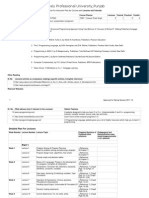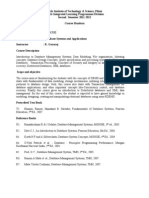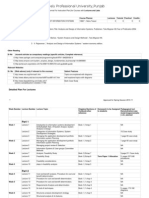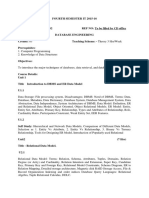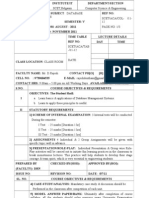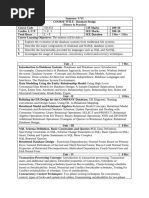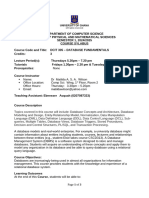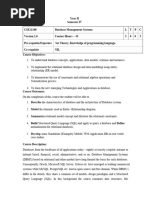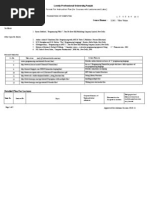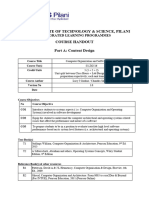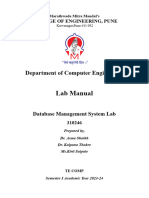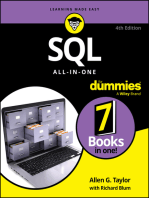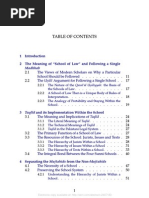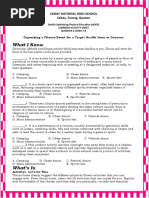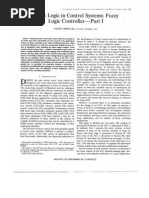Lovely Professional University, Punjab: Detailed Plan For Lectures
Lovely Professional University, Punjab: Detailed Plan For Lectures
Uploaded by
anon_580926649Copyright:
Available Formats
Lovely Professional University, Punjab: Detailed Plan For Lectures
Lovely Professional University, Punjab: Detailed Plan For Lectures
Uploaded by
anon_580926649Original Title
Copyright
Available Formats
Share this document
Did you find this document useful?
Is this content inappropriate?
Copyright:
Available Formats
Lovely Professional University, Punjab: Detailed Plan For Lectures
Lovely Professional University, Punjab: Detailed Plan For Lectures
Uploaded by
anon_580926649Copyright:
Available Formats
Lovely Professional University,Punjab
Format For Instruction Plan [for Courses with Lectures and Labs
Course No CSE351
Cours Title DATABASE SYSTEMS
Course Planner 14858 :: Monica Sood
Lectures Tutorial Practical Credits 4 0 0 4
Text Book:
1 H. F. Korth , S. Sudarshan, A. Silverschatz,Database System Concepts5th Ed., Tata McGraw Hill, New Delhi,2006
Other Specific Book:
2 .Elmasri&Navathe, Fundamentals of Database systems, Addison &Weisely, New Delhi 3 C. J. Date, Database Systems, Prentice Hall of India, New Delhi 4 Ivan Bayross, SQL, PL/SQL the Programming Language of Oracle, BPB Pu 5 S.K. Singh, Database System Concepts,Design,application,Pearson education
Other Reading Sr No Jouranls atricles as compulsary readings (specific articles, Complete reference)
Relevant Websites Sr. No. (Web adress) (only if relevant to the courses) 6 http://www.databasejournal.com/ Salient Features database information
7 http://resources.mha.dk/FileLib/dbsql/Brief_Introduction_to_R RDBMS elational_DBs.pdf
Detailed Plan For Lectures
Approved for Spring Session 2011-12
Week Number Lecture Number Lecture Topic
Chapters/Sections of Pedagogical tool Textbook/other Demonstration/case reference study/images/anmatio n ctc. planned
Part 1
Week 1 Lecture 1 Lecture 2 Lecture 3 Lecture 4 Week 2 Lecture 5 Lecture 6 Lecture 7 Lecture 8 Week 3 Lecture 9 Lecture 10 Lecture 11 Lecture 12 Week 4 Lecture 13 Introduction, Database system applications & Purpose, Comparison with File Mgt System,Database System Structure , Architecture, Instances & Schemas Data Independence, Database Users & Administrator Data Models,Concept & its types, Conceptual data modelling using E-R data model Database design, entities, attributes, relationships ->Reference :1,ch-1 1.1 and 1.2 http://www.nos.org/htm/ dbase1.htm ->Reference :1,Ch11.3 http://en.wikipedia.org/wi 1.111.12 ki/Data_independence ->Reference :1,1.8 1.9 and 1.12 ->Reference :1,1.3 ->Reference :1,1.4 1.5 1.6
Simple practical problems based on E-R data model ->Reference :1,6.1-6.5 having relations Generalization, specialization, specifying constraints ->Reference :1,6.6-6.7 Advanced practical problems based on E-R data model having relations Relational Model Structure of Relational Databases Relational Databases,Def of relation, keys Relational model integrity rules Relational Algebra., relational model operators ->Reference :1,6.8 ->Reference :1,2.1.1 ->Reference :1,2.1.2 ->Reference :1,2.1.3 ->Reference :1,2.2-2.4 ->Reference :1,2.2-2.4 http://en.wikipedia.org/wi ki/Relational_algebra
Part 2
Week 4 Lecture 14 Lecture 15 Lecture 16 Week 5 Lecture 17 Problems based on Relational Algebra Tuple relational calculus Class Test and Discussion Concept of Indexing ->Reference :1,2.5-2.6 ->Reference :1,5.1 ->Reference :1,ch 12 12.1-12.2 ->Reference :1,ch 12.6 to 12.8
Approved for Spring Session 2011-12
Week 5
Lecture 18 Lecture 19 Lecture 20
Concept of Hashing
->Reference :1,3.1 to 3.3 ->Reference :1,Ch8 8.7 8.8 ->Reference :1,1Ch7 7.1 ->Reference :1,1Ch7 7.2 ->Reference :1,1Ch7 7.3 ->Reference :1,1Ch7 7.4 7.5 ->Reference :1,1Ch7 7.6 7.7 ->Reference :1,1Ch7 7.6 7.7 ->Reference :1,1Ch7 7.7 ->Reference :1,1Ch7
Integrity threats, IntegrityConstraints, Integrity rules, ->Reference :1,Ch8 8.6 Security threats, Authorization & Authentication Functional Dependancy, finding Minimal Cover Finding candidate key and problems based on this Normalization- 1NF, 2NF, 3NF and BCNF Decomposition Example Multi valued dependency and 4NF Join dependency and 5NF Problems based on database design
Week 6
Lecture 21 Lecture 22 Lecture 23 Lecture 24
Week 7
Lecture 25 Lecture 26 Lecture 27 Lecture 28
MID-TERM Part 3
Week 8 Lecture 29 Lecture 30 Lecture 31 Lecture 32 Week 9 Lecture 33 Lecture 34 Lecture 35 Lecture 36 SQL: Basic Structure, DDL Set Operations, Aggregate functions, DML Nested Queries, Joins Complex Queries DCL, PL/SQL Subprograms introduction, Packages introduction Cursors introduction Triggers introduction ->Reference :1,Ch3 3.1 -3.3 ->Reference :1,Ch3 3.1 -3.4 3.6 ->Reference :1,Ch3 3.1 -3.7 ->Reference :1,Ch3 3.1 1 ->Reference :2,Ch 9 9.1 ->Reference :2,Ch 9 9.1 ->Reference :2,Ch 9 9.1 ->Reference :2,Ch 8 8.7
Approved for Spring Session 2011-12
Week 10
Lecture 37 Lecture 38 Lecture 39
Problems based on PL/SQL Problems based on PL/SQL Transaction Mgt,Transaction concept & State
->Reference :2,->Reference 2Ch 9 9.4 ->Reference :1,15.115.4
Part 4
Week 10 Week 11 Lecture 40 Lecture 41 Lecture 42 Lecture 43 Lecture 44 Week 12 Lecture 45 Lecture 46 Lecture 47 Lecture 48 Week 13 Lecture 49 Lecture 50 Lecture 51 Lecture 52 Class Test and Discussion Atomicity & durability, Serializability Concurrency Control: Lock Based Time stamp based, & validation based Protocols Multiple granularity, Deadlock Recovery &Automicity Log based Recovery, Shadow Paging Query Processing & Optimization Class Test and Discussion Object Oriented Databases Object Relational Databases Object Relational Databases revision ->Reference :1,9.1 and 9.2 ->Reference :1,9.9 ->Reference :1,22.1 22.2 ->Reference :1,22.3 ->Reference :1,15.515.8 ->Reference :1,16.1 ->Reference :1,16.216.3 ->Reference :1,16.416.5 ->Reference :1,17.117.3 ->Reference :1,17.417.5 ->Reference :1,13.1 and 13.2
Spill Over
Week 14 Lecture 53 Lecture 54 MS SQL Server Parallel Databases ->Reference :1,29.1 ->Reference :1,21.1
Details of homework and case studies
4
Approved for Spring Session 2011-12
Homework No.
Objective
Topic of the Homework
Nature of homework (group/individuals/field work Individual Individual
Evaluation Mode
Allottment / submission Week 3/6 8 / 12 3 / 11
Test 1 Test 2
creative learning creative learning
lecture 1 to lecture 20 lecture 29-lecture 44
manual handwritten handwritten
Design problem 1 To make student aware of how concepts of database are applied in real life
Complete normalized database design along with security, Individual concurrency and recovery policies of any organization working on multi user client server environment
Scheme for CA:out of 100*
Component Test,Design problem Frequency 2 Total :Out Of 3 Each Marks Total Marks 10 10 20 20
* In ENG courses wherever the total exceeds 100, consider x best out of y components of CA, as explained in teacher's guide available on the UMS List of suggested topics for term paper[at least 15] (Student to spend about 15 hrs on any one specified term paper) Sr. No. Topic 1 1 application on any bank 2 application on any hospital 3 application on any university/school 4 application on any retail shop 5 application on any hotel/restaurant 6 application on railway reservation 7 application on airline reservation 8 application on cinema hall booking 9 application on any organization maintaining employees record 10 application on library 11 application on irrigation system 12 application on bus reservation 13 application on Laborarory 14 application on any front office 15 application on any accounting system
Approved for Spring Session 2011-12
Approved for Spring Session 2011-12
You might also like
- Managing the Testing Process: Practical Tools and Techniques for Managing Hardware and Software TestingFrom EverandManaging the Testing Process: Practical Tools and Techniques for Managing Hardware and Software TestingRating: 4 out of 5 stars4/5 (8)
- Antenor Firmim The Equality of The Human RaesDocument11 pagesAntenor Firmim The Equality of The Human RaesMarcello AssunçãoNo ratings yet
- PGM Based Profibus - UpdatedDocument58 pagesPGM Based Profibus - UpdatedpianuelsNo ratings yet
- Databsecse 301Document6 pagesDatabsecse 301Rohit PareekNo ratings yet
- Lovely Professional University, Punjab: Course No Cours Title Course Planner Lectures Tutorial Practical CreditsDocument8 pagesLovely Professional University, Punjab: Course No Cours Title Course Planner Lectures Tutorial Practical CreditsAvinash AnandNo ratings yet
- Lovely Professional University, Punjab: Format For Instruction Plan (For Courses With Lectures and Labs)Document12 pagesLovely Professional University, Punjab: Format For Instruction Plan (For Courses With Lectures and Labs)Priyanka SharmaNo ratings yet
- R PT Instruction PlanDocument7 pagesR PT Instruction PlanGourav GuptaNo ratings yet
- IS ZC332 HandoutDocument4 pagesIS ZC332 HandoutManjunath PatelappaNo ratings yet
- DBMS SyllabusDocument4 pagesDBMS SyllabusRishabh PatelNo ratings yet
- Database Syllabus: I. Course InformationDocument6 pagesDatabase Syllabus: I. Course Informationparameshwar6No ratings yet
- Data StructureDocument7 pagesData StructureKamal CheemaNo ratings yet
- Lovely Professional University, Punjab: Course No Cours Title Course Planner Lectures Tutorial Practical CreditsDocument6 pagesLovely Professional University, Punjab: Course No Cours Title Course Planner Lectures Tutorial Practical CreditsPraveen ChaudharyNo ratings yet
- Data Base Management ENTC - 9-6-2021Document6 pagesData Base Management ENTC - 9-6-2021hrishikeshb.bhavsarNo ratings yet
- Lovely Professional University, Punjab: Detailed Plan For LecturesDocument5 pagesLovely Professional University, Punjab: Detailed Plan For LecturesShivani SinghNo ratings yet
- Cse Ip PDFDocument8 pagesCse Ip PDFSurbhi AgarwalNo ratings yet
- Dbms LabDocument3 pagesDbms LabvrlodhirajputNo ratings yet
- DBMS Lab Manual 7-2-2016Document93 pagesDBMS Lab Manual 7-2-2016janam4bagdai100% (1)
- Detail-Syllabus 4th Semester IT 2015 16 PDFDocument26 pagesDetail-Syllabus 4th Semester IT 2015 16 PDFSaurabh RautNo ratings yet
- Course Information : College of Computing EducationDocument4 pagesCourse Information : College of Computing EducationMartzel Pelicano BasteNo ratings yet
- Cse-3rd & 4TH Sem23062018Document53 pagesCse-3rd & 4TH Sem23062018Sayed Aman KonenNo ratings yet
- DBMS Lesson PlanDocument8 pagesDBMS Lesson PlanGautam DemattiNo ratings yet
- Modern Programming Tools and Techniques-LlDocument7 pagesModern Programming Tools and Techniques-LlKaran SalwanNo ratings yet
- CS 340-Intro To Database Systems-Asim Karim Jamal - Abdul NasirDocument3 pagesCS 340-Intro To Database Systems-Asim Karim Jamal - Abdul NasirHasan AurangzebNo ratings yet
- 2cseaisyll RemovedDocument5 pages2cseaisyll RemovedanushajNo ratings yet
- DBMS SyllabusDocument3 pagesDBMS Syllabustemp76448No ratings yet
- CSC 371 DB-I Ver3.6Document3 pagesCSC 371 DB-I Ver3.6Ihtesham MansoorNo ratings yet
- Cse 316 PDFDocument7 pagesCse 316 PDFSahil ChopraNo ratings yet
- Course Outline DCIT 305 For 2425Document3 pagesCourse Outline DCIT 305 For 2425Andoh davidNo ratings yet
- Data StructureDocument152 pagesData StructureSachin Goyal100% (3)
- Course SyllabusDocument3 pagesCourse Syllabusbalasubramani2234No ratings yet
- Cse 314Document9 pagesCse 314Shikha MishraNo ratings yet
- MaTLab ProgramingDocument7 pagesMaTLab ProgramingKristen VasquezNo ratings yet
- Lovely Professional University, PunjabDocument7 pagesLovely Professional University, PunjabSuraj SinghNo ratings yet
- HTTP App - Utu.ac - in Utuexmanagement Exammsters Syllabus CE4012 Database Management System - Docx - 2Document6 pagesHTTP App - Utu.ac - in Utuexmanagement Exammsters Syllabus CE4012 Database Management System - Docx - 221amtics440No ratings yet
- PUCIT Database Systems Course OutlineDocument5 pagesPUCIT Database Systems Course OutlinemirzamwaqarNo ratings yet
- CSE2007 - Database Management Systems - Revised - 2.0 (CSE)Document4 pagesCSE2007 - Database Management Systems - Revised - 2.0 (CSE)Arnav MohanNo ratings yet
- Bangalore University: Information Science and EngineeringDocument50 pagesBangalore University: Information Science and EngineeringArya G RaoNo ratings yet
- 4th SemestersDocument55 pages4th SemestersSagnik BachharNo ratings yet
- Course Coordinatoi: DR.: SubjectDocument8 pagesCourse Coordinatoi: DR.: Subjectmgrstudio100No ratings yet
- Cit 427 Database Systems and ManagementDocument171 pagesCit 427 Database Systems and Managementimamashraf1100% (1)
- EC601 Course OutlineDocument7 pagesEC601 Course OutlineNorzelan SalehNo ratings yet
- Fundamentals of Databasec OurseoutlineDocument4 pagesFundamentals of Databasec Ourseoutlineyabera528No ratings yet
- DBMSDocument7 pagesDBMSVikram RaoNo ratings yet
- SCHEME - G Fifth Semester (CO)Document42 pagesSCHEME - G Fifth Semester (CO)RazeenKhanNo ratings yet
- Cse310 - Modern Programming Tools and Techniques-IDocument7 pagesCse310 - Modern Programming Tools and Techniques-IBhavit Mittal0% (1)
- Ip CSE101Document10 pagesIp CSE101Paras ChadhaNo ratings yet
- Syllabus in DBMSDocument0 pagesSyllabus in DBMSRavenfoxrodNo ratings yet
- DBMSDocument8 pagesDBMSVikram RaoNo ratings yet
- ComputerOrganizationAndSoftwareSystems Flipped HODocument10 pagesComputerOrganizationAndSoftwareSystems Flipped HOraghunathanNo ratings yet
- Lovely Professional University, Punjab: Detailed Plan For LecturesDocument6 pagesLovely Professional University, Punjab: Detailed Plan For LecturesVeeru VermaNo ratings yet
- COMSATS Institute of Information Technology Abbottabad: Algorithms & Data StructuresDocument4 pagesCOMSATS Institute of Information Technology Abbottabad: Algorithms & Data Structuresumer hayatNo ratings yet
- Cse2007 - Database Management SystemsDocument3 pagesCse2007 - Database Management SystemsMohan GollaNo ratings yet
- Our Lady of The Sacred Heart College of Guimba, IncDocument5 pagesOur Lady of The Sacred Heart College of Guimba, IncEvangeline San JoseNo ratings yet
- Advanced Database Course Sylibus - EditedDocument6 pagesAdvanced Database Course Sylibus - EditedDaniel MelkamuNo ratings yet
- Institute of Business Administration, Jahangirnagar UniversityDocument4 pagesInstitute of Business Administration, Jahangirnagar Universitytanmoy8554No ratings yet
- VJTI MCA Syllabus Sem 3 and 4Document26 pagesVJTI MCA Syllabus Sem 3 and 4RithulRaphelNo ratings yet
- DBMSDocument65 pagesDBMSPRATHAMESH GAYAKENo ratings yet
- Syllabus DBI202Document8 pagesSyllabus DBI202tienndhe181439No ratings yet
- MCSD Certification Toolkit (Exam 70-483): Programming in C#From EverandMCSD Certification Toolkit (Exam 70-483): Programming in C#Rating: 3 out of 5 stars3/5 (2)
- Thermo - Course Outline 208 - Summer 2018Document4 pagesThermo - Course Outline 208 - Summer 2018Stephanie MatsonNo ratings yet
- Case Sheet - Abdominal Lump in Right Lumbar RegionDocument5 pagesCase Sheet - Abdominal Lump in Right Lumbar RegionpradeepNo ratings yet
- Cost Consulting 4th Edition FinalDocument29 pagesCost Consulting 4th Edition Finalprimavera1969No ratings yet
- Application Form For Dealer Distributor 24-11-11Document12 pagesApplication Form For Dealer Distributor 24-11-11Muhammed JazeelNo ratings yet
- F-Search System: 300 Polymers Added To The Polymer LibrariesDocument8 pagesF-Search System: 300 Polymers Added To The Polymer LibrariesRj Anjali AnushaNo ratings yet
- Management of Angry PatientDocument50 pagesManagement of Angry PatientMassy HaddyNo ratings yet
- Practical Guidelines For Evaluation: Restie Allan A. PunoDocument30 pagesPractical Guidelines For Evaluation: Restie Allan A. PunoMartin James Sespeñe100% (1)
- Analytical Writing On Human Rights Cartoon by Liza DonnellyDocument2 pagesAnalytical Writing On Human Rights Cartoon by Liza Donnellytamanh210108100% (1)
- Secrets of Usul by NyazeeDocument132 pagesSecrets of Usul by Nyazeemakmuslim50% (2)
- Unit One Test Answer KeyDocument14 pagesUnit One Test Answer Keyapi-234355963100% (1)
- EVIDENCE ZERO CONDITIONAL-What Happens If...Document5 pagesEVIDENCE ZERO CONDITIONAL-What Happens If...Yan'k SekeaNo ratings yet
- KQ2 - To What Extent Was The League of Nations A SuccessDocument4 pagesKQ2 - To What Extent Was The League of Nations A SuccessJJ SNo ratings yet
- CFLM 102 Leadership AttributesDocument26 pagesCFLM 102 Leadership AttributesKai NyxNo ratings yet
- Titanic World War One and TWO: BirlingDocument3 pagesTitanic World War One and TWO: BirlingSaul CombesNo ratings yet
- The Human Rights of The StatelessDocument16 pagesThe Human Rights of The StatelessNitesh MishraNo ratings yet
- Bows Used by The HunsDocument325 pagesBows Used by The HunsMariusz KairskiNo ratings yet
- Success and Failure Factors of Adopting SAP in ERP System ImplementationDocument21 pagesSuccess and Failure Factors of Adopting SAP in ERP System ImplementationMazhar Hussain Ch.No ratings yet
- 28 Dec 2019 // Nmsdac BulletinDocument2 pages28 Dec 2019 // Nmsdac BulletinNEWCASTLE MULTICULTURAL SDANo ratings yet
- Answersheet Q2 WK 7-8Document3 pagesAnswersheet Q2 WK 7-8Josefina GuintoNo ratings yet
- Tauheed or ShirkDocument9 pagesTauheed or Shirkapi-3799140No ratings yet
- Bio Skema BHG A Kertas 2Document6 pagesBio Skema BHG A Kertas 2amirulNo ratings yet
- CIR V Hypermix FeedsDocument2 pagesCIR V Hypermix FeedsKath LeenNo ratings yet
- Superstore Spec: Friday The 13th Draft2.5Document27 pagesSuperstore Spec: Friday The 13th Draft2.5Brittany MetzNo ratings yet
- 2.regulation of Metabolic PathwaysDocument14 pages2.regulation of Metabolic PathwaysProtusha RakshitNo ratings yet
- Fuzzy Logic Control Systems I Lee 1990Document15 pagesFuzzy Logic Control Systems I Lee 1990hoalnNo ratings yet
- Thesis On Rewards and Employee PerformanceDocument5 pagesThesis On Rewards and Employee Performancevaj0demok1w2100% (2)
- أثر العلاقات العائلية والإجتماعية بين الجاني والضحية في تشديد العقوبة في التشريع الجزائري دراسة مقارنةDocument24 pagesأثر العلاقات العائلية والإجتماعية بين الجاني والضحية في تشديد العقوبة في التشريع الجزائري دراسة مقارنةIlyas ZalarhNo ratings yet
- 6000 Most Common Korean Words 1Document33 pages6000 Most Common Korean Words 1Baggio WongNo ratings yet






